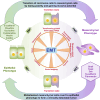EMT signaling: potential contribution of CRISPR/Cas gene editing
- PMID: 32008085
- PMCID: PMC11104910
- DOI: 10.1007/s00018-020-03449-3
EMT signaling: potential contribution of CRISPR/Cas gene editing
Abstract
Epithelial to mesenchymal transition (EMT) is a complex plastic and reversible cellular process that has critical roles in diverse physiological and pathological phenomena. EMT is involved in embryonic development, organogenesis and tissue repair, as well as in fibrosis, cancer metastasis and drug resistance. In recent years, the ability to edit the genome using the clustered regularly interspaced palindromic repeats (CRISPR) and associated protein (Cas) system has greatly contributed to identify or validate critical genes in pathway signaling. This review delineates the complex EMT networks and discusses recent studies that have used CRISPR/Cas technology to further advance our understanding of the EMT process.
Keywords: CRISPR; Cancer; Epithelial–mesenchymal transition; Gene editing.
Figures


References
-
- Brabletz T, Kalluri R, Nieto MA, Weinberg RA. EMT in cancer. Nat Rev Cancer. 2018;18:128–134. - PubMed
-
- Nieto MA, Huang RY, Jackson RA, Thiery JP. Emt: 2016. Cell. 2016;166:21–45. - PubMed
-
- Chu YS, et al. Prototypical type I E-cadherin and type II cadherin-7 mediate very distinct adhesiveness through their extracellular domains. J Biol Chem. 2006;281:2901–2910. - PubMed
-
- Pal M, Bhattacharya S, Kalyan G, Hazra S. Cadherin profiling for therapeutic interventions in epithelial mesenchymal transition (EMT) and tumorigenesis. Exp Cell Res. 2018;368:137–146. - PubMed
Publication types
MeSH terms
LinkOut - more resources
Full Text Sources

